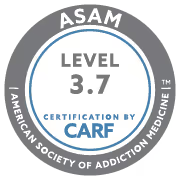Table of Contents
Have you ever found the presence of a purring cat to be soothing after a stressful day at work? Or experienced the overjoyed greeting of a dog lifting up your spirits as you walk through the doors?
Such apparently simple interactions with animals can have a deeper meaning and a profound impact, especially on those walking the path to recovery from addiction or mental health challenges.
The struggle to devise effective and compassionate therapeutic methods has always been challenging. Animal-assisted therapy (AAT) has emerged as a powerful therapeutic intervention that harnesses the unique bond between humans and animals.
This article unravels the transformative power of AAT by highlighting its benefits and understanding how animal companions can contribute to the recovery process.
Understanding Animal-Assisted Therapy
AAT, sometimes referred to as pet therapy, is a formal method of treatment that incorporates the healing power of animals to manage various health conditions. It is typically used as a complement to traditional therapies.
AAT involves the use of specially trained horses, dogs, cats, and even fish and birds as part of a holistic treatment plan. Although it might appear pseudo-scientific, AAT is a widely accepted form of therapy that has measurable objectives and yields identifiable progress.
Based on the patient and their specific conditions, this form of therapy can take various forms and involve different animals. Equine therapy, for instance, is known to help patients with anxiety, while canine therapy is often used to treat individuals with childhood trauma.
The primary goal of AAT is to enhance a patient’s social, emotional, or cognitive functioning.
The Science Behind Animal-Assisted Therapy
Multiple studies over the last decade have shown how mere interaction with animals can trigger the release of oxytocin, a hormone associated with bonding and affection. Incidentally, that is the same hormone that helps mothers bond with their babies.
This hormonal response can reduce stress, lower blood pressure, and alleviate feelings of anxiety and depression. Other studies have shown that petting a dog or cat for just a few minutes can significantly decrease cortisol levels, the hormone responsible for stress.
Animals provide a non-judgmental presence, which is especially beneficial for individuals who may feel isolated or stigmatized due to their physical or psychological condition.
The unconditional love and support offered by therapy animals can help build trust and open communication channels, making it easier for patients to engage in their treatment.
The Role of Pets in Physical Recovery
Physical recovery often involves overcoming substance dependence or pain, regaining mobility, and rebuilding physical and mental strength.
For patients undergoing rehabilitation after surgery, injury, or illness, the presence of a therapy animal can be incredibly motivating. For instance, dogs can assist in physical therapy sessions by encouraging patients to move, walk, or perform exercises. The playful interaction with a dog can distract from the pain and monotony of physical therapy, making the process more enjoyable and less daunting.
Across hospitals and nursing homes, therapy animals provide a sense of normalcy and routine, which is crucial for patients adjusting to long-term care. The simple act of grooming, feeding, or walking a therapy animal can enhance motor skills, coordination, and overall physical well-being.
Emotional and Psychological Benefits
Mental health recovery is a complex and deeply personal journey. For individuals battling addiction or conditions such as depression, anxiety, and PTSD, the emotional support provided by therapy animals can be life-changing.
Therapy animals help reduce symptoms of anxiety and depression. The companionship of a therapy animal can alleviate feelings of loneliness and isolation, providing a consistent source of comfort and security.
Their presence can create a calming environment, which is particularly beneficial in settings like psychiatric hospitals or therapy centers. The routine of caring for an animal can instill a sense of purpose and responsibility, helping individuals develop a more positive outlook on life.
For those with PTSD, especially veterans, interacting with therapy animals can help manage symptoms like hypervigilance, flashbacks, and anxiety attacks. The bond formed with a therapy animal can foster trust and emotional stability, aiding in the overall recovery process.
The Impact on Children and Adolescents
Children and adolescents facing medical challenges, trauma, or mental health issues often struggle with fear, anxiety, and communication difficulties. In that context, AAT can be particularly effective in pediatric settings where traditional therapeutic approaches may not fully engage younger patients.
Therapy animals can help children express their emotions and experiences in a safe and supportive environment.
For instance, a child who is reluctant to talk about their feelings with a therapist might open up while interacting with a therapy dog. In such cases, the animal acts as a bridge, facilitating communication and building rapport between the child and the therapist.
In educational settings, therapy animals can assist children with learning disabilities or behavioral issues. The presence of an animal can reduce stress and anxiety, creating a more conducive learning environment.
Interacting with a therapy animal can also improve social skills, empathy, and self-esteem among children and adolescents.
Implementing Animal-Assisted Therapy
Integrating animal-assisted therapy into a treatment plan requires careful consideration and planning. It involves selecting an appropriate animal, training it for therapeutic interactions, and ensuring the safety and well-being of both the patient and the animal.
Certified therapy animal programs, like those offered by organizations such as Pet Partners or the Alliance of Therapy Dogs, provide rigorous training and certification for therapy animals and their handlers.
Healthcare providers interested in incorporating pet therapy into their practice must collaborate with certified AAT practitioners to design tailored treatment plans that address the specific needs of their patients.
They must also monitor the interactions and outcomes to ensure the therapy's effectiveness and make necessary adjustments.
Self-Assessment and When to Seek Help
If you feel your progress with traditional therapy methods has been limited, introducing a therapy animal might provide the breakthrough needed for meaningful improvement.
Stable relationships with animals, either in therapeutic settings or in home environments, are linked to long-lasting positive effects due to repeated exposure to oxytocin. It's crucial, however, to monitor the response to AAT and adjust the therapy plan as necessary.
Recognizing the early signs that AAT is having a positive impact is vital.
Increased engagement in therapy sessions, improved mood and behavior, and enhanced physical activity are all indicators that AAT is working. If these signs are not present, it may be necessary to reassess and modify the approach.
AAT is a testament to the profound connection between humans and animals. Therapy animals offer more than just companionship; they provide emotional support, motivation, and a sense of purpose.
The healing power of animals extends beyond the physical, touching the very core of human experience and fostering recovery in a way that is both unique and deeply effective.
How Hollywood Hills Recovery Can Help
The presence of a therapy animal can make a significant difference to individuals navigating their path to recovery.
At Hollywood Hills Recovery, we believe overcoming any kind of addiction calls for a personalized and empathetic approach. Our experienced team, many of whom have walked the road to recovery themselves, offers customized support tailored to an individual's unique needs and circumstances.
Get started on your path to an addiction-free, fulfilling life today, through our holistic therapy and treatment plans!












